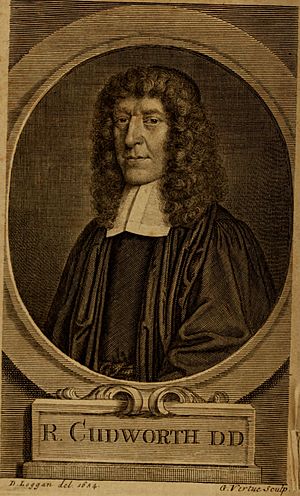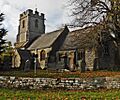Ralph Cudworth facts for kids
Quick facts for kids
The Reverend Professor
Ralph Cudworth
|
|||||||||
|---|---|---|---|---|---|---|---|---|---|
 |
|||||||||
| 11th Regius Professor of Hebrew, University of Cambridge | |||||||||
| In office 1645–1688 |
|||||||||
| Preceded by | Robert Metcalfe | ||||||||
| Succeeded by | Wolfram Stubbe | ||||||||
| 14th Master of Christ’s College, Cambridge | |||||||||
| In office 1654–1688 |
|||||||||
| Preceded by | Samuel Bolton | ||||||||
| Succeeded by | John Covel | ||||||||
| 26th Master of Clare Hall, Cambridge | |||||||||
| In office 1645 (1650) – 1654 |
|||||||||
| Preceded by | Thomas Paske | ||||||||
| Succeeded by | Theophilus Dillingham | ||||||||
| Personal details | |||||||||
| Born | 1617 Aller, Somerset, England |
||||||||
| Died | 26 June 1688 (aged 70–71) | ||||||||
| Spouse |
Damaris Cradock Andrewes
(m. 1654) |
||||||||
| Children | 4, including Damaris Cudworth Masham | ||||||||
| Parents |
|
||||||||
| Relatives | James Cudworth (brother) |
||||||||
| Alma mater | University of Cambridge:
|
||||||||
|
|||||||||
Ralph Cudworth (1617 – 26 June 1688) was an English Anglican clergyman, theologian, and philosopher. He was a key member of the Cambridge Platonists, a group of thinkers at the University of Cambridge. He held important positions, including Regius Professor of Hebrew and Master of both Clare Hall and Christ's College. Cudworth was known for disagreeing with the ideas of Thomas Hobbes. His most famous work is The True Intellectual System of the Universe (1678).
Contents
Ralph Cudworth's Family and Early Life
Ralph Cudworth's father, also named Ralph Cudworth (Snr) (1572/3–1624), was a respected Dr and Reverend. He studied at Emmanuel College, Cambridge, a college known for its strong Puritan teachings. He became a lecturer at St Andrew the Great, Cambridge, and later a rector in Aller, Somerset.
Ralph Snr married Mary Machell in 1611. Mary had important connections, including with the family of King James I. Ralph Snr and Mary had several children while living in Aller. Ralph Snr died in 1624.
Ralph Cudworth's Siblings
- General James Cudworth (1612–82): He became an Assistant Governor and Deputy Governor in Plymouth Colony, Massachusetts. Many American Cudworths are his descendants.
- Elizabeth Cudworth (1615–54): She married Josias Beacham, a rector.
- John Cudworth (1622–75): He was an important businessman in London.
- Jane/Joan(?) Cudworth (born c.1624): She was likely Ralph's sister.
Ralph Cudworth's Education and Career
Ralph Cudworth (Jnr) was born in Aller, Somerset, and was baptized on July 13, 1617. After his father died, his mother married Dr. John Stoughton, who became Ralph's stepfather. Dr. Stoughton made sure Ralph received a good education. Ralph later said he was raised on a "diet of Calvinism".
Student Life at Emmanuel College
In 1630, Ralph Cudworth followed in his father's footsteps and joined Emmanuel College. He earned his Bachelor of Arts degree in 1635/6 and his Master of Arts in 1639. He became a Fellow of Emmanuel College in 1639 and was a successful tutor. He also published two short writings in 1642.
Becoming a Professor and College Master
At just 28 years old, Cudworth was chosen as the 11th Regius Professor of Hebrew in 1645. In the same year, he became the 26th Master of Clare Hall (though he wasn't officially admitted until 1650). He earned his Bachelor of Divinity degree in 1646 and his Doctor of Divinity degree in 1651.
Marriage and Leadership at Christ's College
In 1654, Cudworth became the 14th Master of Christ's College. This was also the year he married Damaris Cradock (died 1695). Damaris was the daughter of Matthew Cradock, who was the first Governor of the Massachusetts Bay Company. This marriage connected Cudworth to important families involved in the American colonies.
Life During the Commonwealth and Restoration
Cudworth was a key member of the Cambridge Platonists, a group of thinkers who generally supported the Commonwealth government. He advised important figures like John Thurloe, who was Oliver Cromwell's Secretary of State.
After the monarchy was restored in England (the Restoration), Cudworth's position as Master of Christ's College was questioned because of his connections to Cromwell's government. However, he managed to keep his job until he died. He was also elected a Fellow of the Royal Society in 1662.
Later Years and Major Work
In 1665, Cudworth almost had a disagreement with his fellow philosopher, Henry More, because More was writing about ethics, a topic Cudworth also planned to write about. To avoid problems, More published his work in Latin.
Cudworth's most important work, The True Intellectual System of the Universe, was published in 1678. He had planned for it to have three parts, but only the first part was finished. He wrote that this part was complete on its own.
Cudworth died on June 26, 1688, and was buried in the Chapel of Christ's College. His portrait hangs in the college hall.
Ralph Cudworth's Children
Ralph and Damaris Cudworth had four children:
- John Cudworth (c.1656–1726): He also studied at Christ's College and became a Fellow.
- Charles Cudworth (died 1684): He worked in factories in India.
- Thomas Cudworth: He graduated from Christ's College.
- Damaris Cudworth (1659–1708): She was a talented and religious woman who became a friend and correspondent of famous philosophers like John Locke and Gottfried Leibniz.
Ralph Cudworth's Philosophy
Ralph Cudworth was a leading figure among the Cambridge Platonists. This group of English thinkers in the 1600s was inspired by the ancient Greek philosopher Plato. They also learned from modern thinkers like Descartes, Hobbes, and Spinoza. Another important philosopher in this group was Henry More.
The Plastic Principle
Cudworth developed an idea called the 'Plastic Life of Nature'. This was his way of explaining how nature works without saying that God directly controls every single thing, or that everything happens by pure chance.
He believed there was a "formative principle" in nature. This principle guides how things grow and move. It's like an inner force that helps nature achieve its goals, similar to how a plant grows from a seed into a specific shape. Cudworth argued that this 'plastic nature' is not intelligent on its own, but it works under the direction of a higher, universal Mind or God.
He thought that if nature was just random particles moving around, it wouldn't make sense. For Cudworth, the universe had a purpose and order because of this 'plastic principle', which was connected to a conscious, knowing Mind.
Ralph Cudworth's Legacy
Cudworth's ideas influenced later philosophers. John Locke, for example, explored how humans gain knowledge. Locke's ideas about the mind being active and organizing experiences were partly inspired by Cudworth.
Thomas Reid, a Scottish philosopher, was also influenced by Cudworth's "Common Sense" philosophy.
Later, George Berkeley developed a similar idea to Cudworth's 'plastic principle' with his concept of an 'aether'. Berkeley thought this 'aetherial medium' caused vibrations that brought all living things to life.
Ralph Cudworth's Works
Cudworth wrote several important works, though some were published after he died.
A Treatise Concerning Eternal and Immutable Morality
This book, published in 1731 after his death, discusses moral philosophy. Cudworth argued against Hobbes's idea that moral rules are simply made up by the government. Instead, Cudworth believed that there are eternal and unchanging ideas of right and wrong, just like there are unchanging truths in knowledge.
A Treatise of Freewill
Another book published after his death (in 1838) was A Treatise of Freewill. In this work, Cudworth explored the idea of free will, which means our ability to make our own choices.
The True Intellectual System of the Universe (1678)
This is Cudworth's most famous and largest work. It was published in 1678. In this book, Cudworth aimed to prove three main things:
- The existence of God.
- That moral differences are natural, not just made up.
- The reality of human freedom.
He spent a lot of time in this book arguing against different forms of atheism, which is the belief that there is no God. He discussed how ancient thinkers viewed the universe and then showed why he believed their ideas were wrong. Some readers misunderstood his detailed arguments against atheism and thought he was an atheist himself!
Images for kids
-
Parish Church of St Andrew, Aller, Somerset: where John Stoughton succeeded Ralph Cudworth Snr (1624)








